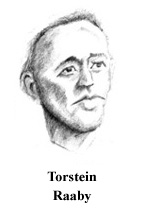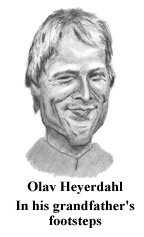The Kon-Tiki Expedition
A Most Merry and Illustrated
Explanation
Many people who grew up in the 1950's and 1960's would have laughed at anyone who had to be told what the Kon-Tiki expedition was. Unfortunately since today you can't learn about it by watching Spike TV or listening to Howard Stern, it seems an increasing number of people think a Kon-Tiki is what you might order if you want to try something other than a Mai-Tai.
The Kon-Tiki Expedition was organized in
1947 by Norwegian Thor Heyerdahl to demonstrate that ancient Peruvian
balsa wood rafts could have transported men from South America to the
Polynesian Islands. Thor had developed a theory that the Polynesians had originated from Peru and
not from Asia, as was usually taught. He had written up his
arguments, and with the 800 page manuscript tucked beneath his arm,
he went to New York to find a publisher.
developed a theory that the Polynesians had originated from Peru and
not from Asia, as was usually taught. He had written up his
arguments, and with the 800 page manuscript tucked beneath his arm,
he went to New York to find a publisher.
Thor quickly found that no one was interested in a theory from a 32 year old college dropout who had largely lived off his wealthy father's income. And they didn't need to waste their time reading his arguments. The Indians from Peru could never have reached the South Pacific, they said. They couldn't get there; they had no boats. All they had were balsa wood rafts.
Well, if the main objection to his theory of racial migration and cultural diffusion (as he called it) was the Indians had no boats, Thor decided there was only one thing he could do. He would go to South America, build the type of vessel they did have, and sail across the Pacific until he hit the South Sea Islands.
The idea was absolutely lunatic. As a boy Thor had been terrified of the water, and he hadn't even been able to swim until he was 22. Now he was going to cross the Pacific on a raft? Ridiculous!
Actually Thor had better credentials than it
might appear. Although he had not graduated college, he had been a
diligent student and had discontinued his formal education so he
could start studying anthropology first hand. Prior to World War II
academic credentials did not necessarily mean a Ph. D. Some
professors in world renown universities (particularly in history and
social sciences) had no degrees higher than a baccalaureate. So in
1937 (and with his dad's money) Thor decided he and his twenty-year
old wife, Liv, would go and live on Fatu Hiva, one of the South
Pacific Marquesas Islands.
Expecting to find the noble savage happily gamboling about in a tropical paradise, Thor quickly found it was more like a palm bedecked Purgatorio. Some of the natives were nice, others quite cantankerous, and some were downright mean. The noble savage wasn't always that noble, either, and the couple were deliberately swindled when the natives built them a hut from easily obtainable green bamboo rather than wood that was properly cured. The result was a fine powder that floated out from the walls and got into their hair, eyes, and lungs.
But the real problem was disease. Tuberculosis and elephantiasis were particularly common. Thor and Liv themselves contracted what the native called fe-fe where their legs erupted in hideous boils, some as large as teacups. When the infection spread to where it was reaching toward Thor's more strategic parts and Liv was barely able to walk, they decided something more than the natural native remedies were called for. They got a native to row them to a nearby island where one of the inhabitants had some modern medical training. He was able to stop the spread of the infection, and both Thor and Liv recovered. But Thor lost his toenails.
[Note: Percy Smith, a famous and early New Zealand ethnologist, identified fe-fe as elephantiasis. Thor and Liv did not have that disease. So either Percy was wrong, Thor was wrong, or fe-fe was a more or less generic name for diseases that produced ugly looking legs, arms, or other appendages.]
When the couple returned to Fatu-Hiva, they found their house overgrown, rotted, and infested with insects. Liv herself was once bitten by a huge centipede. The incident, although not life threatening, put her out of commission for a while. They moved to a cave by the sea so they could keep a look out for a boat, any boat, that could take them the hell away from their tropical paradise. Finally a ship showed up and took them away.
The experience had a sobering effect on Thor's "back-to-nature" philosophy, and he realized that many people in big cities were far healthier and happier than the natives on Fatu-Hiva. In later years he took care to avoid any semblance of conflict with the missionaries and government officials who were charged with bringing civilization to the out of the way places he often found himself. To some this might have looked like rank opportunism, but it really did reflect Thor's honest beliefs.
Although in some ways his trip to the Marquesas had been a way for Thor to get away from the real world, he nevertheless had seriously studied the Marquesas culture. It was from comparing the stone statues in the Marquesas and Peru and looking at the wind and surf patterns that he began to think Polynesia had been settled from South America.
Following his return home, he wrote a short book on Fatu-Hiva (not the Fatu-Hiva he penned thirty-five years later), as well as articles for the National Geographic and other magazines. He had also been elected to New York's Explorer's Club, and in an effort to carve a career on something other than living off his dad, he began giving talks on his experiences. Liv, though, said no more back-to-nature life for her, and eventually she and Thor separated.
Further studies were interrupted in the 1940's when Thor volunteered to fight with the Norwegian Free Forces. It was only after the war that he was able to write his theory down in an organized form. But when he got to New York none of the experts would even bother reading his manuscript. Bold action was called for and Thor began to make plans to build the raft and sail to Polynesia.
Although the president of the Explorer's Club thought Thor was nuts and didn't bother reading his book, another senior member, Peter Freuchen, came to his aid. At that time Peter was one of the most famous arctic explorers alive, and Peter's support could mean a lot in getting an expedition going. When Thor outlined his plans at the club on a cold rainy November evening, Peter didn't think that crossing the Pacific by raft was crazy at all. Certainly not as crazy as trying to camp in Greenland in mid-winter in a pup-tent with a frozen zipper. So with Fruechen on-board (so to speak), things began to move fast.
Of course, what Thor needed was money. Normally his dad might have put up a good chunk of cash, but according to Thor, currency restrictions made it impossible to exchange the Norwegian kroner for American dollars. But then an adventurous Norwegian millionaire (with his capital a bit more fluid) said he'd help finance the expedition if no other funds could be found. The US and British Armies agreed to provide provisions and equipment, and the president of the North American Newspaper Alliance (NANA) agreed to pitch in provided Thor agreed to give the NANA first publication rights. Most importantly a rich New York patron with two "energetic young reporters" stepped in with the lion's share of the ready cash if Thor would agree to a series of lecture tours. Thor could now get moving.
If you read Thor's book, he claimed that once everything was set up, his chief "backer" (very ambiguously described) came down with the flu and couldn't authorize releasing the actual money. So his two buddies agreed to dissolve the partnership and let Thor handle everything himself. Which left Thor, as he said, in the streets with his hands in his pockets.
It seems strange that a case of flu could stop the signing of a few checks or that the expedition couldn't wait a few days for their backer to get better. So it should surprise no one that the story given by Thor was a tactful evasion of what really happened. In short, it just wasn't true.
What really happened was as soon as Thor's financing was set up, everyone with the dough started getting cold feet. The rich millionaire also backed out. NANA still said they'd help but wouldn't pay the full amount unless Thor got halfway across. Thor naturally asked what the hell good would a check be to him if he had already built the raft and was in the middle of the ocean. In any case, it looked like the plans for the expedition were off.
Then the Norwegian consul, Colonel Otto Munthe-Kaas, heard the promised financing wasn't shaping up and advanced Thor $1000 out of his own pocket. This revived some faith in the expedition and brought in some other supporters. One drawback was all the money was in the forms of loans which would have to be repaid (and with interest). But at least Thor now had enough money to go to Peru and build the raft.
As touch and go as the financing had been, it
was a snap finding members who would be willing to go along on what
the National Geographic Society's technical consultants said was a
suicide mission. The first member Thor had recruited was Herman
Watzinger, a refrigeration engineer working for a Norwegian firm and
who was in America on a business trip.
Herman had met Thor purely by chance in the cafeteria of the Norwegian's Sailor's Home in New York where Thor was staying. A few years older than Thor, Herman asked his new acquaintance what brought him to New York. Thor outlined his plans, and when they bumped into each other a few days later, Herman offered to quit his job and go along on the raft. Herman did have a family back in Norway, but Thor's dad stepped in and offered to support them and the families of other expedition members for the duration of the voyage.
It was Herman who suggested the expedition have a radio and operator to maintain whatever outside contact would be possible on a deck heaving and rolling a foot or so above the water's surface. Although Thor didn't like the idea, he was finally convinced and called on two radio experts from the Norwegian wartime resistance, Knut Haugland and Torstein Raaby. Thor had met Knut, who was still a major in the Norwegian army, during his training and he had bumped into Torstein after he re-entered Norway. No doubt feeling that crossing the ocean on a balsa raft was child's play compared to engaging in radio espionage in occupied Norway and (for Knut) having the occasional shootout with the Germans, both men agreed to come.
The other member Thor picked was a boyhood
friend, Erik Hesselberg. At the time Erik was an amateur artist and
the only one on the expedition who was an experienced seaman. He had
sailed around the world a couple of times, acquired his navigator's
certificate, and now lived with his wife, Liss, and his infant
daughter, Anne Karin. Liss seemed to have no problem letting her
husband go off (literally) to the other side of the world for eight
months or so. So after receiving Thor's invitation, Erik traveled to
Panama by boat, and from there he flew on to
Peru.
An unexpected air of academic respectability came to the expedition when Bengt Danielsson knocked on the door of Thor's hotel room in Lima. A graduate from the University of Uppsala, Bengt had been studying the Indians of South America. He had just arrived in Peru from the inland by canoe. By now there had been considerable newspaper play about the Kon-Tiki expedition and Thor was wary of the academic Danielsson when he walked in. Thinking the Swede was going to trash his theory, he was surprised when Bengt mildly told him he thought the idea was interesting and asked if he could join the expedition.
Before leaving New York, Thor had obtained valuable diplomatic contacts at the United Nations. Now following a personal interview with the Peruvian president, he obtained permission to build the raft in the naval dockyard in Callao, the seaport suburb of Lima. The raft was christened the Kon-Tiki after the legendary (but as Thor believed, real) pre-Inca figure that Thor believed left South America by his raft only to show up as the Polynesian deity named Tiki.
As Thor told it, once the experts looked at the raft there wasn't a single stick, rope, or knot that wasn't guaranteed to send them to the bottom. The dimensions were wrong, the raft would snap in two, the ropes would wear away, and the balsa logs would suck up water like a sponge. Pick any reason, baby, they'd never make it.
Some of the warnings, though didn't really -
pardon the bad joke - hold water. After all, there was no doubt that
the balsa rafts could get onto and navigate upon the open sea.
Francisco Pizzarro encountered one in the ocean that was nearly as
large as his own ship. Although modern experts claimed the Incas had
to dry the rafts out every two weeks to keep them from sinking, what
really happened (as Thor found out) was the sap in the freshly cut
balsa logs kept the water from seeping in. Also none of the experts
ever questioned why the Indians would have continued to use a type of
vessel for hundreds or even thousands of years if they needed to
refit their lashings every two weeks. Balsa rafts were still being
used in the nineteenth century making voyages up and down the South
American coast and even going out to the Galapagos, 650 miles west of
Equador.
Other dangers, though were real enough. Footing on the bamboo deck was treacherous and in rough seas, waves could easily knock a man overboard. In fact, Herman once went over the side and only quick action on Knut's part saved him. Although the crew did encounter a couple of storms, which admittedly kept them busy, luckily they were not hit by any full blown typhoons which could have splintered both the raft and the six expedition members.
The expedition began on April 28, 1947 with the raft being towed by tug to get them outside the shipping lanes and (it has to be admitted) to give them a bit of a leg up on getting away from the coastal currents and wind patterns. On August 7, after 101 days at sea, the raft literally crash landed on Raoria Reef in the Tuamotu Archipelago. The only non-minor injury was when the mast fell and cracked Danielsson on the noggin, leaving him with a concussion from which he quickly recovered.
Four days later and with the crew still on Raoria, Thor's by-line appeared on a story in the New York Times. Obviously a somewhat garbled re-write transmitted by radio, the story got the basics correct but erred in a number of details. In addition to confusing the names of the crew with their backgrounds, the men were identified as Swedish, an error which likely amused Danielsson who was the sole Swede on board. In any case, Thor had proven his point. Not that Polynesia was peopled from Peru, he was quick to admit, but that the South Sea islands were in reach of the water craft used in ancient America.
Thor and the others returned to America on a Norwegian ship sent specially to pick them up. Thor's gratitude was somewhat dampened when on their arrival in San Francisco the captain handed him a travel bill for $10,000. Later though, the ship's owner met him for dinner and told him to forget about it.
Thor became an instant celebrity and ultimately the #1 national hero of Norway. After some unexpected delay in finding a publisher, his book, Kon-Tiki: Across the Pacific by Raft, became one of the best sellers in the twentieth century. Still in print, it quickly sold tens of millions of copies and has been translated into virtually every language on earth (numbers between 60 and 70 are usually cited). Thor also produced a motion picture from footage shot on the voyage, a film which won the Oscar for Best Documentary in 1951, an honor it clearly merited.
It was the movie's early success that made it possible for Thor to pay off the loans. But it also got him sued by a hula dancer who appeared on screen for about 20 seconds. She said no one told her that she would appear in a movie and using the scene degraded her and her culture. But she felt that $150,000 would relieve most of her humiliation.
The lawsuit was filed in the United States since at that time American law was strict on requiring film makers to get permission from anyone appearing in a film. Thor's lawyers, convinced they would lose, recommended settling out of court. But Thor decided to fight the suit all the way. He won and the ruling set an important legal precedence in the amount of freedom documentary film makers were allowed.
The success of the movie, and more importantly, his book gave Thor enough capital where he was literally able to write his own ticket, Thor conducted excavations on the Galapagos Islands in 1952 and Easter Island in 1956 (which got him another best seller and another film). As always he felt his findings supported his theory of migration and cultural diffusion.
It's sometimes supposed that the Kon-Tiki expedition fully vindicated Thor's ideas and his theories were finally accepted by scholars. It is true that immediately after the voyage and his dig on Easter Island, there was some openness toward of his ideas, and Thor published a number of papers in academic journals. But mostly he met resistance and even ridicule.
What irritated Thor most was that before the voyage, the experts said the Indians couldn't reach Polynesia since all they had were balsa wood rafts. Now they were saying the voyage meant nothing because the Indians didn't really have those type of balsa wood rafts anyway. Worse, Thor was accused of being an experienced seaman (not true) and that all he proved was five modern Norwegians and one Swede subsisting on modern army rations and building a raft with the aide of the Peruvian navy could float across the ocean. But the undeniable truth is that if five landlubbers and one graduate of navigation school could float across the Pacific on a balsa wood raft, the ancient Peruvians with generations of experience to draw on could make it as well.
But unfortunately (for Thor) today when scholars and ethnologists may have no objection with the basic idea of population migrations - and even those who at one time may have thought Thor's ideas were good ones - most anthropologists and ethnologists still consider Thor's basic theory incorrect. Instead his techniques are more often looked on as how to use selective data mining to build false theories and improper correlations.

There's nothing that will kill a good theory like more data, and further linguistic studies and (more conclusively) DNA sequencing have shown that the current Polynesians indeed originated from Asia, not South America. Conclusive evidence, some say, that Thor was wrong. But Thor replied he had never said current Polynesians were from South America. If they'd just read his damn books they'd realize he proposed that there was a contact of two cultures - one from Asia; the other from South America - and the one from Asia won out.
But, his opponents countered, excavated bones from Polynesia showed no South American genes. Surely that would not be the case if some of the population came from America. Thor then countered that the Polynesians who had come South American had cremated their dead and so nothing remained to test. Now modifying theories to meet objections is generally OK, but once Thor started saying he knew he was right because there was no evidence, some people began to label his theories as pseudoscience.
Not surprisingly what captured the popular imagination often hurt Thor in the eyes of traditional academia. In the late 1960's he and an internationally composed crew floated from Egypt to Central America on a papyrus raft named the Ra. To many this was just Thor trying to recapture the by-gone days of his past glory, and the term "stunt" archeology was coined.
Invective between Thor and his detractors continued to get downright nasty. Some opponents even seized on Thor's phrasing that a "white", "fair-skinned" race from Peru was the civilization that was responsible for the advanced features of Polynesian culture. After all, Thor had said that the astronomical knowledge and advanced calendar used by the Polynesian seafarers was "certainly" not from the Asia or Malay Peninsula. Thor, an ardent opponent of Fascism and bigotry, now found his theories dismissed as nothing more than the old racist doctrine that you had to be Caucasian to do anything worthwhile.
To his credit, Thor could develop professional collaborations and even personal friendships with people who disagreed with him. His expedition to Easter Island was with the help of two American archeologists Edwin N. Ferdon and William Mulloy. Neither of these men ever bought onto Thor's ideas and Mulloy once went so far as to tell Thor, "I don't believe a damn thing you've published", a remark Thor thought was funny. But he still gave the two archeologists money and manpower for their excavations and did so with no strings attached. Other archeologists and ethnologists who were willing to treat him as a peer found a discussion with Thor was a stimulating exercise and couldn't help but like and respect the man.
Regardless of the rights or wrongs in the arguments on either side, labeling the theory behind the Kon-Tiki expedition as pseudoscience is certainly unfair. It was, in fact, a fine theory and was based on first hand observations and a careful review of previous research. Yes, it's probably wrong, but you still have to wonder.
The basic message of the Kon-Tiki is it
was not a fluke. Not only did Thor manage to sail other small craft
across the major oceans, but in 2006, the Tangoroa Expedition
repeated almost exactly the Kon-Tiki's trip using a copy of the raft.
Although the leaders of the expedition admitted the evidence against
Thor's theory was strong, the expedition was organized both as a
means to gather scientific data from the Pacific up close without the
disturbance that major ocean going research vessels create, but also
as a well-merited tribute to Thor. So it was fitting that his
grandson, Olav, went along.
The Kon-Tiki expedition infected Raaby with the exploration bug and no doubt aided by his association with Thor, he undertook other trips and travels. Unfortunately while attempting to reach the North Pole on a sledge trip in 1964 he unexpectedly died. He was only 44.
Erik returned to his wife and daughter and built something of a reputation as a painter and sculptor. He later got a boat of his own and sailed the Mediterranean painting as he went. He also served as a designing consultant for various establishments that wanted a Kon-Tiki motif. Like Thor, he wrote a book about the voyage, the entertaining "Kon-Tiki and I" which he also illustrated. Ostensibly written for children, the book (which mentions the difficulty of trying to eat your food at a Polynesian banquet when the hula dancers wear nothing beneath their grass skirts) can also be enjoyed by adults. He died in 1972.
Herman ended up doing very well. Although he may have liked the Polynesian islands, there were limited employment opportunities there for a refrigeration engineer. Peru, though, was a good compromise between living in the tropics and pursuing a modern career. Herman moved to Lima and began a number of business ventures associated with Peru's fishing industry which allowed him to use his engineering expertise. He ended up as the Norwegian consul to Peru. He died in 1986.
While he was in Lima waiting for the raft to be built, Bengt had met a young French woman named Marie-Thérèse and the year after the expedition, they married and moved to Tahiti. Bengt continued to study the culture and people of Polynesia while maintaining his connections with Swedish academia. He earned his Ph. D., and dividing his time between Sweden and Polynesia, became the director of Sweden's National Museum of Ethnology. More mainstream than Thor's, his research had a decent standing among the majority of the academic community. He eventually became Sweden's consul to Tahiti and seeing the post-war changes hitting the South Seas, Bengt was highly critical of how dumping thousands of megatons of nuclear weapons on various Polynesia islands effectively destroyed (among other things) the inhabitant's self-sufficiency. He died in 1999.
Thor himself kept going strong quite literally to the end. In his later years he organized expeditions which ranged from the Canary Islands to the Black Sea and became increasingly concerned and vocal about the environmental damage done to the oceans by industrialized countries. He died in 2002 in Italy where he lived with his third wife, Jacqueline Beer, who was Miss France for the Miss Universe contest in 1954.
Knut Haugland remained a career military man and later helped set up and manage the Kon-Tiki Museum in Oslo where the original raft remains on display. On Christmas Day, 2009 and at age 92, Knut died, the last member of the Kon-Tiki Expedition.
Bibliography and Related Reading
Books
"Kon-Tiki Across the Pacific by Raft", Thor Heyerdahl, (F.H. Lyon, Translator), Rand McNally. This is the book by Thor. Many editions are available from 1950 on, and it currently remains in print. A true classic whether you believe Thor's theories or not.
The film is available on DVD. Despite the disclaimer that it was the work of amateurs using primitive equipment, the film was converted from 16 mm to 35 mm by professional film makers for Thor using the first optical printer in Europe. The film is really very well done and is worth watching.
"American Indians in the Pacific: The Theory Behind the Kon-Tiki Expedition", Thor Heyerdahl, Rand McNally, 1953. In the back of most American editions of "Kon-Tiki" it sounds like this was the original manuscript. The truth is Thor reworked it considerably after he got back from Polynesia. This gives the theory and Thor's arguments. Out of print and used copies are on the pricey side.
"Senor Kon-Tiki", Arnold Jacoby, Rand McNally, 1967. A biography written by a boyhood friend of Thor and fills in some additional details not found in Thor's book. No longer in print, but fairly cheap copies can be found.
"Thor Heyerdahl http://www.plu.edu/~ryandp/thor.html, Donald P. Ryan. An Internet article which lists most of Thor's publications. From the web site of archeologist Donald Ryan of Pacific Lutheran University.
"Aku-Aku: The Secret of Easter Island", Thor Heyerdahl, Rand McNally, 1958 . Another bestseller by Thor, but not quite in the same league as "Kon-Tiki", and it's not currently in print. Used (cheap) books are available, though. Mostly this is about Thor's own dealings with the people living on Easter Island but also covers his theories, none of which are really accepted today. This was also made into a film which is amusing and entertaining, but has probably not even been shown on television in thirty years and is not (apparently) available on DVD.
An on-line history of Easter Island can be found at http://islandheritage.org/eihistory.html and the site specifically discusses Thor's ideas at http://islandheritage.org/heyerdahl.html in a fairly balanced and not too antagonistic manner (they don't believe Thor though).
The book "Aku-Aku" is particularly interesting as it shows how Thor tended to over-praise the local authorities. Read his remarks about the military governor and the Jesuit missionary - about their honor and integrity - and then read some of the histories of Easter Island written after the 1960's.
Unfortunately buttering up the authorities was necessary if you wanted to do any scientific studies there. Chile was, you may remember, a military dictatorship for most of its history and if you didn't say nice things about them, they didn't invite you back. Even a National Geographic article ("Easter Island and It's Mysterious Monuments") written in 1962, while deploring the capture and murder of the islanders by early slave traders, stated how "peace came" in 1888 when Chile annexed the island.
The truth was a bit more sordid, but quite typical of colonial rule over "native" people. From 1888 and up to Thor's time and beyond, the average Rapa Nui lived under what can only be described as horrible slum-like conditions imposed by the Chilean government while the island was still being used as a massive sheep farm managed by absentee corporate landlords. With a sheep population of 40,000 the animals outnumbered the humans by about 20 to 1 and were allowed more freedom. At night the people were kept confined to a single fenced-in village and were subject to strict military rules which included public floggings.
Finally in 1965 one of the teachers on the island got a bellyful of what was going on and wrote an open letter that generated so much bad press that (with just a wee bit of help from some Rapa Nui activists) got things changed to where the island was administered like any other Chilean community.
Still, Easter Island scholarship remains contentious even today since it seems people who write about it have difficulty separating their own politics and world view from the island's actual history. Environmentalist have seized on it as an example of how the ancient people of this now denuded island destroyed their environment and degenerated their society into chaos, warfare, and cannibalism. Anti-environmentalists, on the other hand, say the environmentalists should not be blaming an indigenous people for what was really a modern phenomenon caused by outsiders and tens of thousands of sheep. Likely the truth is a combination of information from both sides.
Most people on Easter Island now speak Spanish, not Polynesian, and tourism is big business. There are direct international flights, nice hotels, and at the time of this writing, there is talk of putting in a casino. This horrifies many nature purists, who, when not bemoaning about the deterioration of the world and the environment, might themselves head off on a gambling junket in Jersey, Vegas, or just about anywhere else.
Articles
"Kon-Tiki Trip Ends on Pacific Reef", Thor Heyerdahl, New York Times (NANA Release), April 11, 1947. Thor's first Kon-Tiki article written (or rather transmitted) while on Raoria.
"Voyager Against All Tides", Water Gibbs, Time Magazine, April 21, 2002
"Thor Heyerdahl", Guardian Unlimited, Jo Anne Van Tilburg, April 19, 2002
"Thor Heyerdahl", The Scotsman (Uncredited), April 19, 2002
Thor's wife, Jacqueline Beers, is head of Thor Heyerdahl Research Foundation. Completely off topic, in the 1960's she also acted in a number of films and television programs, one of which was The Recollector's Affiar of the Man from Uncle.
"Knut Haugland", The Telegraph. A fairly full account of Knut's adventurous life. Online at http://www.telegraph.co.uk/news/obituaries/military-obituaries/special-forces-obituaries/6901543/Knut-Haugland.html